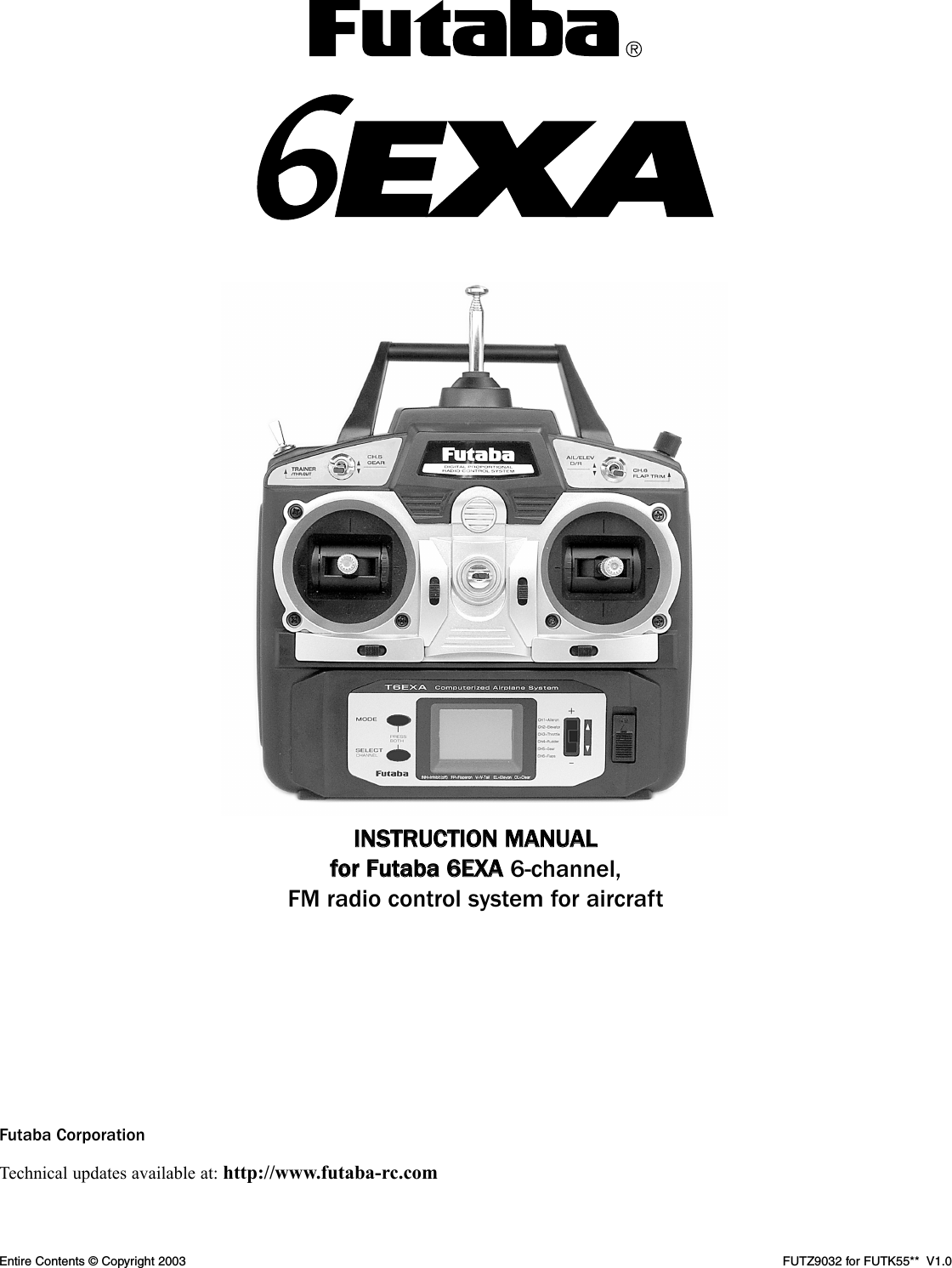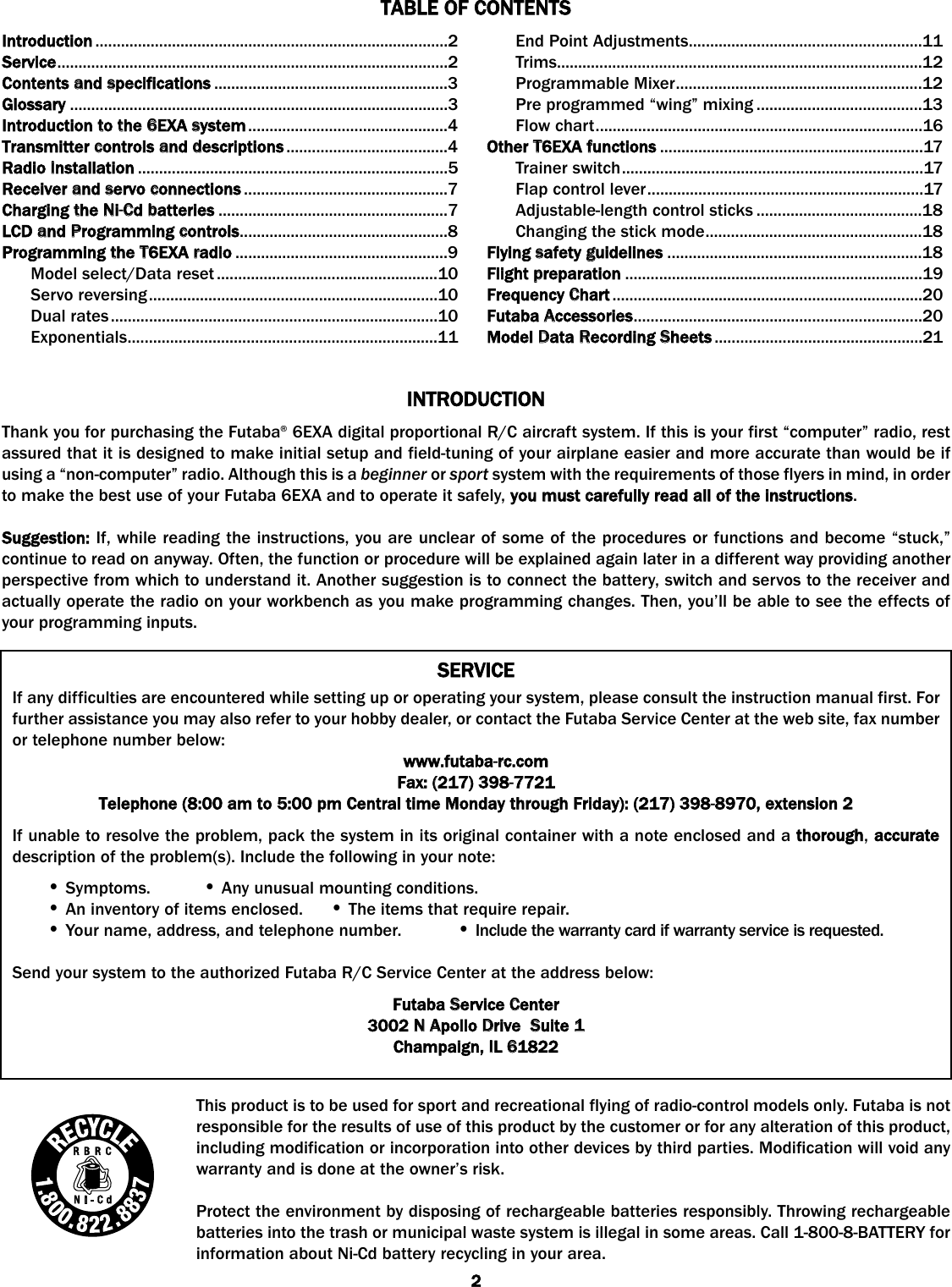Futaba T6EXA-72 6 Channel Aircraft Radio Control User Manual 6EXA2
Futaba Corporation 6 Channel Aircraft Radio Control 6EXA2
Futaba >
Contents
- 1. Users Manual Part 1
- 2. Users Manual Part 2
- 3. Users Manual Part 3
- 4. Users Manual Part 4
Users Manual Part 1


![GLOSSARYIt will be helpful to understand the following terms before reading the rest of the manual. The terms are not in alphabeticalorder, but are in a logical order that prepares the reader for understanding the next term.Reversing ((servo rreversing) – A function that allows the user to determine the direction of response of each servo. If, afterhooking up the servos, a control on the model responds in the wrong direction, the user may change the servo’s direction sothe control responds correctly. Throw – When speaking of a control surface (such as an elevator or aileron), the throw is thedistance the surface moves. Control surface throw is usually measured at the trailing edge of thesurface and is expressed in inches or millimeters. The model in the diagram has 1/2" [13mm] ofup elevator throw. Throw can also refer to the distance a servo arm (or wheel) travels. Dual rrate ((D/R) – On the 6EXA the dual rate switch allows you to instantly switch, in flight,between two different control throws for the aileron and elevator. Often, different controlthrows are required for different types of flying. (“Low” throws may be required for flying athigh speeds where the model’s response becomes more sensitive, and “high” throws may be required for aggressive aerobaticmaneuvers or landing or flying at lower speeds where the model’s response becomes less sensitive.) End ppoint aadjustment ((E.P.A.) – Sets the overall, maximum distance the servo rotates in either direction. (No matter where thedual rates are set, the servo will never travel beyond the limit set by the end point adjustment.) Exponential – Normally, servos respond proportionally to control stick input from the transmitter (e.g., if the stick is moved halfway,the servo will move halfway). However, with “exponential,” the servo can be made to move more or less than initial stick movement(less servo movement is more common). Exponentials are commonly used to “soften,” or decrease initial servo travel for the aileronsand elevators. This way, initial control stick inputs from the pilot result in small servo movement for a smoother flying airplane. (Dualrates adjust the amount of servo travel. Exponentials determine where most of the travel will occur.)Mixing – Two (or more) servos can be made to operate together either by mechanically joining the wires (with a Y-connector)or by electronically “joining” them through programming functions in the transmitter. When servos are electronically joined viaprogramming, they are said to be “mixed.” Unlike joining servos with a Y-connector, when servos are mixed electronically theycan be made to move in opposition. Additionally, each servo’s end points can be independently set. 3Transmitter:T6EXA Transmitter with programmable mixing and 6-modelmemory. Transmitting on 72 MHz band.Operating system: 2-stick, 6-channel systemModulation: FMPower supply: NT8S600B 9.6V, 600 mAh Ni-Cd battery Current drain: 250mAReceiver:R127DF narrow band, FM seven-channel receiver. Receiving on 72 MHz band.Type: FM, Dual conversionIntermediate frequencies: 455kHz, 10.7MHzPower requirement: 4.8V or 6V Ni-Cd batteryCurrent drain: 14mA @ 4.8VSize: 1.39x2.52x0.82” (35.3x64.0x20.8mm)Weight: 1.5oz (42.5g)Receiver BBattery:NR-4J 4-cell (4.8 Volt) Capacity: 600mAhWeight: 3.4oz/95gServos:Four S3004 ball bearing servos with mounting hardware and servo arm assortment Control system: Pulse width control, 1.52ms neutralPower requirement: 4.8V (from receiver)Output torque: 44.4oz-in [3.2kg-cm]Operating speed: 0.23sec/60°Size: 1.59x0.78x1.41” [40.4x19.8x36mm]Weight: 1.3oz [37.2g]*Specifications and ratings are subject to change withoutnotice.Other ccomponents:• SWH-13 switch harness with charging jack• 9” [150mm] aileron extension cord (to facilitate quick connectingand disconnecting of aileron servo with removable wing)• Flap control lever• AC overnight battery charger• Frequency clip • Neck strap• Servo mounting tray• Instruction manualCONTENTS AAND SSPECIFICATIONS](https://usermanual.wiki/Futaba/T6EXA-72.Users-Manual-Part-1/User-Guide-311484-Page-3.png)